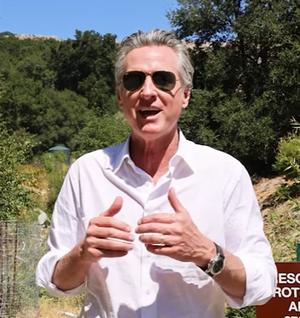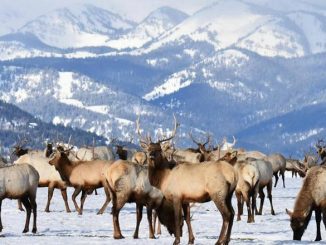
SACRAMENTO, California, July 8, 2025 (ENS) – Building toward its goal of conserving 30 percent of its lands and coastal waters by 2030, the State of California has protected over one million acres of land and coastal waters in the last year, an area roughly equivalent to the size of Glacier National Park in Montana.
As of June this year, 26.1 percent of California’s lands and 21.9 percent of its coastal waters are under long-term conservation and care, bringing the state well within reach of its 30×30 target.
California committed to its 30×30 conservation plan in the year 2020. Now, five years later, California’s 2025 30×30 Progress Report released July 7 marks the halfway point toward the state’s 30×30 goal.
Since tracking began in April 2022, California has added 2.3 million acres of land toward the 30×30 goal.
Monday’s announcement came as the Trump administration continues its assault on public lands and National Parks. Last month, the Newsom administration sent a letter to the U.S. Department of the Interior warning of public safety risks and reduced access due to major cuts proposed to staff and programs that support National Parks and other federal public lands.
By contrast, California is expanding access to the outdoors, investing in communities and laying the groundwork for further expansion.

“President Trump and radical Republicans may not see the value of protecting our lands and waters but California does. We’ve conserved millions of acres of lands and coastal waters – adding an area equivalent to Glacier National Park in just the last year – and bolstered our partnerships with tribal nations and local communities. We’re proving that conservation isn’t just good for nature. It’s critical for people, too,” Governor Gavin Newsom said.
Since Governor Newsom launched California’s 30×30 initiative in 2020, and with the passage of Senate Bill 337 in 2023, the state has made historic investments and thousands of Californians have come together to protect the landscapes that make California unique.
The 2025 report shows progress on 104 of the 112 action steps in the Pathways to 30×30 strategy, the state’s roadmap released in 2022 to guide implementation of the California conservation plan.
During the past year, for the first time, California has made major additions to marine conservation areas, following extensive tribal consultation, scientific guidance, and public input.
“This progress report reflects years of hard work by thousands of Californians, from tribal leaders to ranchers, scientists to surfers,” said California Natural Resources Secretary Wade Crowfoot. “It’s a midpoint, not a finish line, but through continued work together we will achieve this important target.”
Highlights of California’s 2025 30×30 Progress Report include:
- – State funding for record levels of conservation, including Wildlife Conservation Board grants supporting the acquisition of 50,000 acres, with $180 million state dollars leveraging around $120 million of funding from other sources. These investments support conservation of key wildlife corridors, wetlands and creeks; as well as construction of infrastructure that ensures access to nature for all.
- – The state has increased tribal partnership through historic levels of ancestral land return to California Native American tribes, co-management agreements, and bringing beneficial fire back to the landscape to restore healthy forests. More than 150 years after California banned the practice of cultural burning, California can now enter into agreements with federally recognized tribes – honoring tribal sovereignty, healing historical wrongs, and benefiting biodiversity.
- The Karuk Tribe established the first agreement in February 2025, which empowered tribal cultural fire practitioners to conduct planned burns using traditional ecological knowledge.
- – California has passed Proposition 4, the $10 billion Climate Bond approved by voters in November 2024, which will drive continued progress on 30×30, climate resilience and wildfire preparedness.
- – The state has launched a new marine conservation framework, adding thousands of acres of coastal waters as 30×30 Conservation Areas. This action plan identifies new potential 30×30 designations and engages with previously designated areas to ensure meaningful biodiversity outcomes and balanced sustainable ocean uses.
The progress outlined in the 2025 30×30 report reflects the work, leadership and deep collaboration among tribal governments, local communities, landowners, conservation organizations, scientists, and public agencies.
Over the past three years, California has allocated more than $1.3 billion in state funding to support 30×30 implementation. This is on top of the state’s historic investment of more than $1 billion for expanding parks and nature access, including to Californians who live in underserved communities.
The 30×30 Global Connection
In January 2012, the High Ambition Coalition for Nature and People, a leadership group that now includes 121 countries, created a task force to mobilize states and provinces to achieve 30×30. This commitment was formalized in December 2022, at the UN Biodiversity Conference (COP15), where 190 countries adopted the Kunming-Montreal Global Biodiversity Framework, which commits to this goal.
The task force is building partnerships across borders and acting as a knowledge-sharing platform to improve the ways subnational governments are implementing 30×30.
Collaboratively led by California and Quebec, over the past year, task force members hosted technical webinars on key 30×30 strategies and opportunities, as well as on lessons learned on diverse topics such as protected area management and Indigenous led conserved areas. They also hosted events to highlight global leadership at the United Nations Biodiversity Conference of Parties (COP16) in Cali, Colombia, in October 2024.
Finally, California’s Marine Protected Area Network, a critical component of its 30×30 strategy in coastal waters, has achieved recognition as the international gold standard for marine conservation. This network was officially accepted to the International Union for Conservation of Nature (IUCN) Green List of Protected and Conserved Areas, a high-profile international certification that recognizes the most successful examples of biodiversity conservation worldwide.
Featured image: Protected giant redwood trees in California’s Humbolt County. (Photo courtesy Hike Then Wine)



